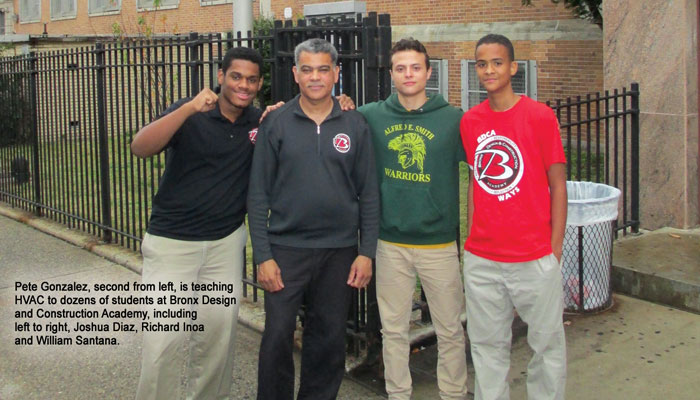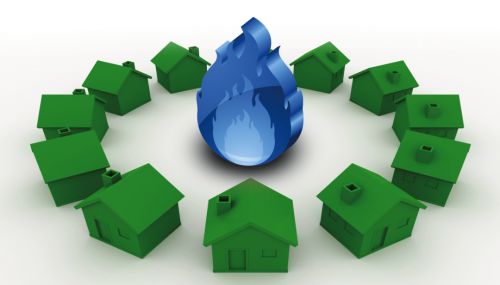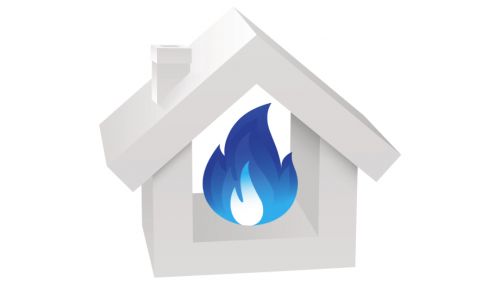All
Learning the Science of Bioheat® Fuel
by John MacKenna

The New York Oil Heating Association (NYOHA) is helping a teacher in Bronx, NY, incorporate clean-burning Bioheat® fuel as a teaching tool in an interdisciplinary approach to HVAC training.
Pete Gonzalez is teaching the science of Bioheat® fuel – as well as math, chemistry and English – to 17 Bronx Design and Construction Academy juniors this fall, with NYOHA’s support.
In addition to arranging for 150 gallons of pure B100 Bioheat® fuel and equipment to be donated by AMERIgreen Energy and Schildwachter Oil Company, Rocco Lacertosa, NYOHA’s CEO and a member of the school’s HVAC Advisory Board, recently visited the classroom to speak directly to the students.
“We are very proud to support the excellent work that Pete Gonzalez is doing to help prepare New York City students for a future in the Bioheat® fuel industry,” said Lacertosa.
“New York City has mandated a 2 percent biodiesel blend, and one of the things I’m trying to do is educate the students on Bioheat® fuel and the importance of the industry going green,” Gonzalez said.
During the classroom session, NYOHA helped the students gain insider views of the Bioheat® fuel industry. Lacertosa spoke about work opportunities in Bioheat® fuel companies, and AMERIgreen Energy’s Michael Devine provided an in-depth look at the environmental benefits of Bioheat® fuel as well as the fuel’s appeal to consumers. Peter Schildwachter, of Schildwachter Oil Company, also visited the class and donated new equipment.
Encouraging Exploration
Gonzalez has devised a curriculum of exploration in which his HVAC class learns through experimentation and reporting. The students are blending small quantities of heating oil and biodiesel and paying careful attention to the blend ratios. They burn various Bioheat® fuel blends up to 99 percent biodiesel in heating equipment and use combustion analysis tools to profile the emissions at each level.
“NYOHA has been tremendously helpful to the school and its students through the years,” Gonzalez said. “The transition to Bioheat® fuel is helping New York City reduce emissions and create a healthier environment. If my students can learn about this fuel, they can help make New York a greener city.”
New York City created a new standard for heating oil in 2012 when it required all fuel companies to use a blend of ultra low sulfur heating oil and at least 2 percent biodiesel. In addition, New York State requires the use of ultra low sulfur heating oil, which has 99 percent less sulfur than traditional heating oil. As a result, the heating oil that heats many New York City homes and buildings is the cleanest in the country.
Experimenting with different blend levels is a timely exercise, because the New York City Council is now considering a proposal to raise the biodiesel blend level to 5 percent in 2016 and 20 percent by 2030. “It is important that the blend level goes higher to make the emissions cleaner,” Gonzalez said. “Our work here parallels what the City is doing to be an environmental leader.”
Gonzalez chose to do the Bioheat fuel experiments with a junior class instead of a senior class “because the kids are inexperienced, and they have no bias.” Before they started working with the blended fuels he taught them the basics of firing up an oilheat system and conducting combustion tests. The classroom is outfitted with eight boilers, and each one is outfitted with a small fuel reservoir that feeds the burner. The students mix small quantities of fuel using graduated cylinders and beakers to make precise measurements. Many of them are making precise liquid measurements for the first time, so Gonzalez had them learn by mixing different types of soda before moving on to the heating fuels.
For each live experiment, a group of students mixes heating oil with B100 to a precise blend level. They pour the blended fuel into the reservoir on one of the burners and then fire the burner, observe the flame and use combustion analysis tools to profile the emissions. After their testing, the students are required to write reports describing what they discovered.
Interdisciplinary Approach
Gonzalez has recruited colleagues Jonathan Brown, Nathaniel Thayer Wight, Adam Ellias and Alrick Crowe to broaden the scope of the HVAC course to include mathematics, chemistry, physics and English. Brown, a chemistry teacher, said he is helping the students evaluate the design of their experiments to ensure that they are generating valid results.
Physics teacher Nathaniel Thayer Wight said he hopes to integrate the physics in his class with the physics of Bioheat fuel. “Such integration will offer opportunities for teachers to synchronize standards across the disciplines and will result in an increased and comprehensive understanding of the science of biodiesel. This integrated project is in alignment with a major goal of ours at Bronx Design and Construction Academy: to make our students more competitive for post high school employment and for higher education opportunities,” he said.
Math also comes into play as the students learn to blend fuels in specific ratios and analyze the components of the combustion gases. The students are sharpening their English skills as they write reports about their experiments.
Gonzalez increases the level of engagement by letting the students design their own experiments. Rather then tell them what blend ratios to use, he asks them to make those choices and report their results accurately. “This can create a better experience for the students,” he explained. “If it’s all too structured, they can get bored.”
Competitive Spirit
The Bioheat® fuel experiments are a unique twist in this year’s HVAC course at Bronx Design and Construction Academy. The students are also learning the essentials of indoor heating, including service, installation, piping and troubleshooting.
One of the highlights of the school year for the HVAC students is an interscholastic skills competition, where they face off against teams from William E. Grady High School in Brooklyn, NY, and Saunders Trades and Technical High School in Yonkers, NY. “We normally base our curriculum around that, and it is one of the assessment tools we use,” the teacher explained. “It works out well, because they are motivated to compete against the other schools.”
Gonzalez is a former oil burner technician himself. He worked in the industry for 17 years before the Academy’s HVAC teacher persuaded him to apply for the position. “It was not in my plan. It was the last thing I expected to do – the last job I would ever consider taking. And I hated it for the first six months.” Before long, though, he came to appreciate the motivation and willingness of the students. “It clicked, and then it became the best thing I’ve ever done.”
Related Posts
 The Possibilities of Renewable Propane
The Possibilities of Renewable Propane
Posted on March 13, 2024
 Propane Can Do That
Propane Can Do That
Posted on March 12, 2024
 Take Action and Take Control of Your Future at Industry Summit VI and Visions ‘24
Take Action and Take Control of Your Future at Industry Summit VI and Visions ‘24
Posted on March 11, 2024
Enter your email to receive important news and article updates.






